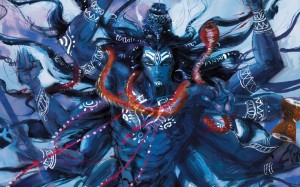Shiva
By Julian Millane
Shiva is part of a series on this website about Indian Spiritual Mythology
Shiva is one of the principal Hindu deities, who with Vishnu and Brahma forms the Trimurti or triad of great gods. Shiva is a Sanskrit word meaning “auspicious one”.
He is the Moongod and lord of the mountains, with the moon in his hair from which flows Ganga, the sacred river Ganges.
Shiva contains all the contradictory aspects of human nature.
He is the joyful Lord of the universal dance and fiery destroyer of demons, archetypal celibate yogi and drunken seducer of the sages’ wives, haunter of funeral grounds and embodiment of irrepressible vitality.
Shiva’s vehicle or vahana is Nandi, the bull (the joyous).
He represents Shiva’s virility and fertility and is instinctual power and impenetrable strength.
He is the son of the divine cow Surabhi, who arose from the churning of the primordial ocea One myth about Shiva concerns the 10,000 rishis (sages).
Shiva visited them in order to persuade them to become devotees. The rishis responded by cursing him and sent a fearsome tiger to devour him.
The great god simply removed the skin of the tiger and draped it around him. They then sent a snake to attack Shiva who merely draped it around his neck.
They then sent an evil dwarf demon upon which Shiva placed his foot and proceeded to dance. Eventually the rishis could resist no longer and threw themselves at his feet.
Shiva is often shown with a third eye, the eye of inner vision in the middle of the forehead. He frequently has a serpent as a necklace and others wrapped around his arms.
He may be depicted smeared with ashes as a symbol of his ascetism. His throat chakra is often coloured blue, due to the important role he played in the myth of the churning of the ocean.
According to this popular tale the great snake Vasuki was used as a rope to turn Mt Mandara and so churn the seas in order to produce amrita, the elixir of immortality.
The snake became exhausted and vomited his venom, which would destroy all existence.
Shiva saved the world by swallowing the poison, which stained his throat.
His trident represents the trinity of creation, preservation and destruction and the Damaru drum, duality. The damaru also represents the pulse of Time.
Shiva is also the god of Time and thus The Great Destroyer.
He sits in Abaha Mudra, giving the gesture of protection. The new moon is associated with Shiva and is often called the Shiva Moon.
The sliver moon represents the primary perception of the yogi’s inner vision, the barely perceptible only seen with the inner vision.
Other aspects of Shiva’s vast nature are as Tripurantaka, “He who puts an end to the three towns” – the three worlds of earth, space and sky.
Shiva- Rudra also relates to Shiva’s role as the periodic annihilation by the great Lord of the created universe.
As Pashupati he is depicted as “The Herdsman, the Owner of Cattle and Lord of the Beasts”, and as Nataraja the “Lord of The Dance”.
Originally published in Here & Now magazine.
Written by Khalid Julian Millane, joint owner of Shikara Design, importer of Asian artifacts, furniture and carpets, and who has an endless fascination with Eastern mythology and history.
Share Shiva with your friends on Facebook

Leave a Reply